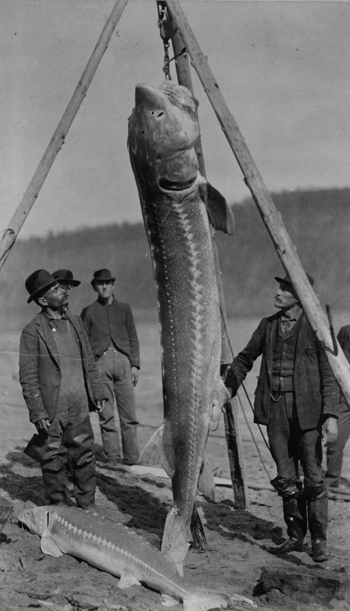Sturgeon Critical Habitat Proposed
by Laurie Schreiber

Population estimates for the Kennebec River system indicated 10,240 adult sturgeon prior to 1843. Currently it’s estimated to have less than 300 adults spawning each year.
PORTLAND—The New England Fishery Management Council (NEFMC) is reviewing proposals for designating critical habitat Atlantic sturgeon in tidally-affected riverine waters of coastal estuaries of the Gulf of Maine, New York Bight, and Chesapeake Bay.
The proposal would not affect marine waters.
“Identifying critical habitat puts a new level of review” on federal agencies, NEFMC executive director Tom Nies at NEFMC’s June meeting. “With the hope being that, if you reduced federal activity on sturgeon, sturgeon might recover more quickly. That’s a somewhat tenuous link.”
The proposed areas include waters of the Penobscot , Kennebec , Androscoggin, Piscataqua, and Merrimack Rivers; Connecticut, Housatonic, Hudson, and Delaware Rivers; and Susquehanna, Potomac, Rappahannock, York/Pamunkey/Mattaponi, and James rivers.
Lynn Lankshear, Atlantic sturgeon recovery coordinator for the Greater Atlantic Regional Fisheries Office’s (GARFO) Protected Resources Division, told NEFMC the designations don’t create preserves or refuges, and there would be no blanket prohibition on in-water activities.
The designation’s purpose, she said, is to require federal agencies to consult with GARFO when such agencies are carrying out, funding, or authorizing activities that might affect critical habitat. The federal agency would work with GARFO to avoid or minimize potential impacts to Atlantic sturgeon habitat. The activity of the federal agency might need to be modified to avoid destroying or adversely modifying the critical habitat.
According to NEFMC, Atlantic sturgeon are anadromous, meaning that adults spawn in freshwater in the spring and early summer and migrate into estuarine and marine waters, they spend most of their lives. Historically, Atlantic sturgeon were present in approximately 38 rivers in the United States from St. Croix, Maine, to the Saint Johns River, Fla., of which 35 rivers have been confirmed to have had a historical spawning population. Atlantic sturgeon are currently present in approximately 32 of these rivers, and spawning occurs in at least 20 of them.
Overharvest from commercial fishing led to widespread declines in Atlantic sturgeon abundance from the 1950s-1990s. Current threats include bycatch of sturgeon in fisheries targeting other species, habitat degradation and loss, habitat impediments such as locks and dams, and ship strikes.
Atlantic sturgeon is managed by the Atlantic States Marine Fisheries Commission (ASMFC). In 1998, the ASFMC instituted a coast-wide moratorium on it harvest of Atlantic sturgeon. NMFS followed with a similar moratorium for federal waters.
The Chesapeake Bay, New York Bight, Carolina, and South Atlantic population segments are listed under the Endangered Species Act. The Gulf of Maine population is listed as threatened.
The Gulf of Maine population continues to see significant declines in population sizes and a protracted period during which sturgeon populations have been depressed; a limited amount of spawning; and continued impacts and threats expected to continue to prevent population recovery, according to NEFMC information. Population numbers of Atlantic sturgeon in the Gulf of Maine are significantly lower than historical levels and have remained so for the past 100 years. For example:
• Population estimates for the Kennebec river system based on the landings from historical fisheries indicated that approximately 10,240 adult sturgeon were present prior to 1843. Currently, the existing spawning population is estimated to have less than 300 adults spawning each year.
• Spawning is known to occur in only one river (Kennebec), possibly in one other (Penobscot).
There are some positive signs for the Gulf of Maine distinct population segment, according to NEFMC information. That includes observations of Atlantic sturgeon in rivers from which sturgeon observations have not been reported for many years and potentially higher catch-per-unit-effort.
